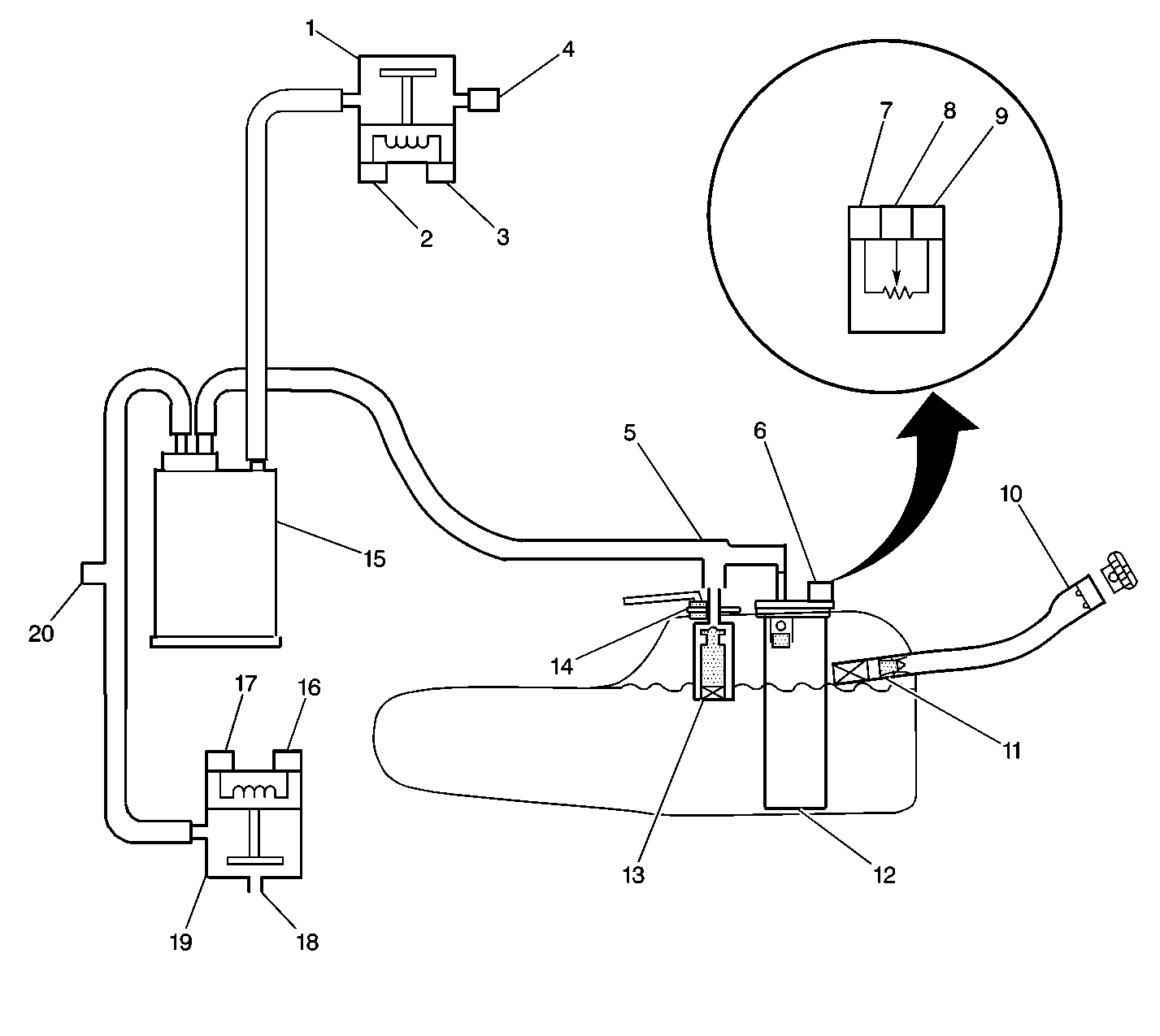Refer to
EVAP Control System Overview

System Description
The EVAP canister purge valve allows manifold vacuum to purge the canister. The powertrain control module (PCM) supplies a ground to energize the purge valve. The EVAP purge valve control is pulse width modulated (PWM) or turned ON and OFF several times a second. The pulse width, or duty cycle, is determined by the engine operating conditions including the engine load, the throttle position, the engine coolant temperature, and the ambient air temperature. The duty cycle is calculated by the PCM and the output is commanded when the appropriate conditions have been met.
The EVAP vent valve is used to seal the EVAP system during diagnostic tests. The fuel tank pressure (FTP) sensor is used to monitor the vacuum in the system during the diagnostic tests.
A stuck-closed EVAP canister purge valve, stuck-open EVAP vent valve, disconnected or damaged EVAP purge line or vent hose, leaking fuel cap, or fill neck should set DTC P0440. A small leak in the EVAP system should set DTC P0442. An EVAP vent valve stuck closed, a restricted vent hose, or a blocked EVAP canister should set DTC P0446. An EVAP purge valve stuck open or leaking should set DTC P1441. Refer to the DTC tables for further diagnostic procedures regarding the EVAP system.
The EVAP system includes the following components:
| • | The EVAP canister |
| • | The EVAP canister purge valve |
| • | The EVAP vent valve |
| • | The EVAP vapor pipes |
| • | The EVAP purge pipes |
| • | The EVAP fresh air vent hose |
| • | The fuel tank |
| • | The fuel pipes and hoses. |
| • | The fuel fill cap |
| • | The fuel fill pipe |
Diagnostic Aids
Check for the following conditions:
| • | A cracked or punctured EVAP canister |
| • | A damaged or disconnected source vacuum line, EVAP purge line, vent hose, or fuel tank vapor line. |
| • | A poor connection at the PCM |
| • | Inspect the harness connectors for the following conditions: |
| - | Backed-out terminals |
| - | Improper mating |
| - | Broken locks |
| - | Improperly formed or damaged terminals |
| - | Poor terminal-to-wire connections |
| • | A damaged harness. Inspect the wiring harness to the EVAP vent valve, the EVAP purge valve, and the FTP sensor for an intermittent open or short circuit. |
| • | Any kinked, pinched, or plugged vacuum source, EVAP purge, or fuel tank vapor line. Verify that the lines are not restricted. |
| • | Any carbon being released into the system |
Step | Action | Values | Yes | No | ||||||||||
|---|---|---|---|---|---|---|---|---|---|---|---|---|---|---|
1 | Did you complete the Powertrain On-Board Diagnostic (OBD) System Check? | -- | ||||||||||||
2 | Did any other DTC set? | -- | Go to the applicable DTCs | |||||||||||
3 | Inspect the EVAP system for the following conditions:
Did you find and correct the condition? | -- | ||||||||||||
4 |
Is the fuel tank pressure near the specified value? | 0 kPa (0 in. H2O) | Go to DTC P0453 Fuel Tank Pressure Sensor Circuit High Voltage | |||||||||||
5 |
Important: DO NOT exceed the pressure in the specified value. Did you achieve pressure equal to the specified value? | 1.25 kPa (5 in. H2O) | ||||||||||||
6 | Use the EVAP service station to maintain the fuel tank pressure at the specified value. Does the fuel tank pressure equal the specified value? | 1.25 kPa (5 in. H2O) | Go to DTC P0452 Fuel Tank Pressure Sensor Circuit Low Voltage | |||||||||||
7 | With a scan tool, command the vent valve OFF. Does the pressure decrease to near the specified value within 2 minutes with the rotary switch in the Off/Hold position? | 0 kPa (0 in. H2O) | Go to DTC P0446 Evaporative Emission (EVAP) Vent System Performance | |||||||||||
8 |
Does the fuel tank pressure decrease to the specified value within 15 seconds? | 0 kPa (0 in. H2O) | Go to DTC P1441 Evaporative Emission (EVAP) System Flow During Non-Purge | |||||||||||
9 |
Important:: Do not exceed the pressure in the specified value. Does the EVAP pressure decrease to less than the second specified value within 2 minutes? | 15 in. H2O 10 in. H2O | Go to DTC P0442 Evaporative Emission (EVAP) System Small Leak Detected | System OK |
